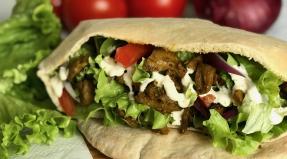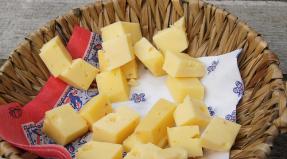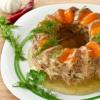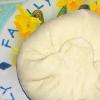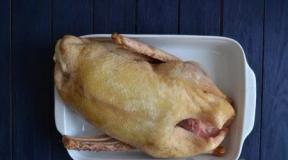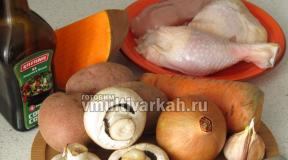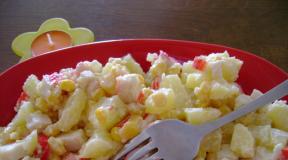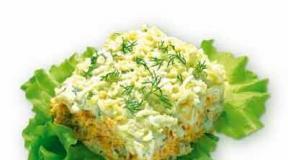Dishes from Soviet canteens. Cuisine of the USSR: favorite dishes of the Soviet people (11 photos)
Soviet cuisine absorbed the traditions of completely different peoples, from the northwestern Baltic states to Central Asian nomads. Therefore, Uzbek shurpa is as familiar and dear to us as Russian cabbage soup. Many soups included in the golden fund of Soviet cuisine have a distinctive feature: they warm perfectly, and many even replace the entire dinner, that is, they are very high in calories. We recall what warming and hearty soups the republics of the Soviet Union were famous for.
Russia
Solyanka, borscht, pickle, fish soup… There are a lot of important soups in Russian cuisine. But cabbage soup is our food. And, perhaps, the most important dish for Russia. Let's leave borscht to Ukraine, although this is also our soup, too.
Shchi from sour cabbage
Photo: Shutterstock.com
700-800 g lean beef (shoulder or edge)
500 g sauerkraut
608 medium potatoes3 carrots
3 medium onions
2 parsley roots
Black peppercorns
Bay leaf
Saucepan - 5 l
Step 1. Rinse the meat, pour cold water over it, bring to a boil, remove the foam, cook for 1.5 hours after boiling, remove the foam periodically.
Step 2. An hour after laying the meat, wash and peel the onions and carrots. Finely chop the onion, grate the carrots on a coarse grater.
Step 3. Slowly fry the onion in odorless vegetable oil; when it becomes transparent, add the carrots. Wait until it becomes soft.
Step 4. While the vegetables are fried, peel the potatoes, cut them into cubes.
Step 5. Remove the meat from the broth, remove from the bones, if necessary, cut into large cubes. Put back into broth.
Step 6. Add potatoes to the broth. Cook for 5-10 minutes (depending on the size of the cubes).
Step 7. Add sauerkraut to the soup.
Tip: cabbage should be good, crispy, not salty and not sweet!
Step 8. Add onions and carrots. Then add the parsley root, pepper and bay leaf. Salt. Wait 5-10 minutes.
Step 9. Turn off and let it brew for about 20 minutes. Serve with herbs.
Ukraine
Borsch
South Russian and Ukrainian borscht is distinguished by a special fatty broth. It is boiled either on beef brisket or pork, or two types of meat are mixed.
700 g pork ribs

Photo: Shutterstock.com
3 potatoes
2 onions
2 carrots
2 tomatoes
1/3-1/2 head of cabbage
A piece of lard2-3 teeth garlic
Black peppercorns and bay leaf
Step 1. Wash the meat, pour cold water over it and cook the broth for 1.5 hours.
Step 2. Peel and cut the potatoes into large cubes, add to the broth.
Step 3. Fry the beets, cut into strips, in a pan.
Step 4 Separately fry the onion and carrots until golden brown. Add them to the beets.
Step 5. Add grated tomatoes or tomato paste to the roast.
Step 6. Remove the meat from the broth, remove it from the bones and cut into small pieces.
Step 7. Add vegetables to the broth, put the meat there, simmer over very low heat.
Step 8. Add shredded cabbage to soup. Cook it until soft.
Step 9. Crush lard with garlic and salt. Add to borscht and turn off.
Step 9. Salt and pepper if necessary, let it brew for 10 minutes. Serve with greens.
Belarus
There are many excellent soups in Belarus. We decided to stop at potato. Because Belarusian cuisine and potatoes are the same thing.
Tertyukha

Photo: Shutterstock.com
5 large potatoes
1.5 l meat broth
100 g smoked brisket150 ml cream
20 g butter
Salt, black pepper, herbs
Step 1. Peel and grate potatoes.
Step 2. Put in a boiling broth (you can just water).
Step 3. Cook for 10 minutes, then add butter
Step 4. Pour in the cream, bring to a boil.
Step 5. Remove from heat and add salt, pepper, herbs.
Step 6. Fry the brisket in a dry frying pan. Add a spoonful to each bowl of soup.
Georgia
Kharcho

Photo: Shutterstock.com
600 g beef
2 onions
4 tomatoes
Piece of tklapi with polladoni6 tbsp rice
½ cup chopped walnuts
1 parsley root
Greens (cilantro, parsley, green basil)
1 hot pepper
Suneli hops, saffron, allspice
½ head of garlic
Vegetable oil
Step 1. Cut the beef into large cubes and cook with parsley root and bay leaf, removing the foam, in 3 liters of water until tender. About an hour and a half.
Step 2. Remove the beef from the broth, strain the broth. Remove bay leaf and parsley root.
Step 3 Rinse the rice and put it into the broth.
Step 4. Peel and finely chop the onion. Saute in vegetable oil.
Step 5. Grind walnuts in a blender or grate, or turn through a meat grinder. Add them to the onion.
Step 6. Remove the skin from the tomatoes, finely chop and add to the onions and nuts. Fry everything for 5 minutes.
Step 7. Add the fry to the rice. Put the beef in there. Bring to a boil, add tklapi and turn off.
Step 8. Grind the greens, rub the garlic with salt (you can pass it through the press).
Step 9. Put greens, garlic, spices into the soup. Close the lid and let it brew for 10 minutes.
Moldova
Zama

Photo: Shutterstock.com
1 soup chicken
1 carrot
2 onions
1 parsley root1 hot pepper
Parsley and celery greens
Kvass for okroshka
homemade noodles
Step 1. Cut the chicken into portions and boil.
Step 2. Add 1 onion in the husk to the chicken, carrots, parsley root, hot pepper, a little kvass and greens.
Step 3. Chop a whole raw onion. And boiled in the broth - remove. Cut carrots.
Step 4 Boil the noodles separately, rinse and add to the broth.
Step 5. Add celery and sour kvass (can be replaced with lemon juice). Bring to a boil and turn off the heat.
Kazakhstan
Shurpa

Photo: Shutterstock.com
500 g lamb
5 potatoes
2 carrots
2 onions
2 bell peppers
1 head of garlic
1 lemoncilantro, suneli hops, black pepper and salt
Step 1. Boil the lamb over low heat, removing the foam, adding the onion. Boil the broth for 1.5-2 hours.
Step 2. Remove the meat from the broth, discard the onion.
Step 3. Add chopped potatoes and carrots to a slightly boiling broth. Cook for 30 minutes over low heat.
Step 4. Put the diced pepper.
Step 5. Cut the cooked meat into pieces and add to the soup.
Step 6. Throw whole apples into the pan.
Step 7. Boil for half an hour, then remove the apples and put coarsely chopped tomatoes into the soup.
Step 8. Finely chop the garlic, add to the soup, squeeze the lemon juice into it. Simmer the soup for another 30 minutes.
Step 9. Turn off, salt and add spices, let it brew for 10 minutes. Serve with greens.
Uzbekistan
Kaymak Shurpa
400 g sour cream
2 onions
Several ears of corn300 g pumpkin
Step 1. Chop the onion, add it to the sour cream and simmer until the onion is soft.
Step 2. Pour water, bring everything to a boil and add corn on the cob, cut in half.
Step 3. Add diced pumpkin and cook for half an hour.
Step 4. Turn off, salt, add cilantro.
Azerbaijan
Kyufta bozbash

Kyufta bozbash. Azerbaijan Photo: Shutterstock.com
500 g lamb
3 tbsp rice
2-3 potatoes
1 tomato
1 bulb
½ cup chickpeas
Some dried mint
Dried cherry plum
Step 1. Soak the peas two to three hours before cooking.
Step 2. Boil rice. Put the peas to boil.
Step 3. Turn the meat into minced meat along with cherry plum and onion. Add rice to minced meat.
Step 4. Roll up large meatballs.
Step 5. Boil water, salt and put the meatballs. When they surface, reduce the fire.
Step 6. Cook for 40 minutes.
Step 7. Peel the potatoes, add to the soup and cook over low heat. Put half-cooked peas there.
Step 8. Add a whole tomato, turmeric.
Step 9. When the potatoes are cooked, turn off the soup, salt and pepper. Sprinkle with dried mint when serving.
Lithuania
Borscht with ears

Photo: Shutterstock.com
Sugar pit for broth
2 l mushroom broth
2 medium beets
2 onions
2 carrots
1 parsley root
1 tbsp vinegar
Bay leaf
Salt and pepper
2 cups of flour
3-4 tbsp water
1/2 handful dry mushrooms + 2-3 mushrooms for broth
Butter
1 bulb
Pepper and salt
Step 1. Cook the broth from the bones by adding the onion, carrot, parsley root, bay leaf and allspice.
Step 2. 40 minutes before the end of cooking, add beets, chopped into strips, vinegar
Step 3. Soak the mushrooms, then drain and pass through a meat grinder.
Step 4. Fry the onion and add it to the mushrooms, also put the greens there.
Step 5. Boil the mushroom broth.
Step 6. Knead the dough from flour and eggs.
Step 7. Roll out and mold dumplings with mushroom filling from it.
Step 8. Strain the broth with beets and mix with strained mushroom broth.
Step 9. Put ears in hot soup and cook for a couple of minutes.
Step 10. Serve ears in hot broth with herbs.
Latvia
beer soup

Beer soup. Latvia Photo: Shutterstock.com
500 ml beer
100 g sugar
Step 1. Boil beer with cumin.
Step 2. Grind sugar with yolk, dilute with cold beer and pour everything into hot beer, stirring.
Step 3. Put on fire, heat up, but do not bring to a boil.
Step 4. Serve with croutons.
Estonia
Milk fish soup

Milk fish soup. Estonia Photo: Shutterstock.com
1 kg cod
1 liter of milk
1.25 liters of water
1 half liter can of chopped potatoes
1 bulb
2 tbsp butter
1 tbsp flour
1 tbsp chopped dill
Step 1. Cook the fish in boiling water for no more than 10 minutes, then remove it.
Step 2. Put potatoes, finely chopped onions, parsley into the broth, salt and cook for another 10-15 minutes.
Step 3. Dilute the milk with water, stir the flour in it and add it to the broth with vegetables.
Step 4. Cook, stirring, until the potatoes are ready, then put the previously removed fish fillet, add dill, oil and heat for 2 more minutes.
Step 5. Remove from heat, close the lid and let stand for 3-5 minutes
Kyrgyzstan

Lagman Photo: Commons.wikimedia.org
150 g beef
2 tbsp butter
½ onion
10 g tomato puree
80 g radish
2 garlic clove
1 tbsp 3% vinegar
Pepper, herbs, salt
Step 1. Knead unleavened dough from flour and a small amount of water. Roll it out very thin and cut into homemade noodles.
Step 2. Cut the meat into small pieces and fry until crispy.
Step 3. Then finely chop the onion and radish and fry together with the meat. Add pepper and salt.
Step 4. Put the tomato puree, chopped garlic into the roast, pour in the broth.
Step 5. When serving, warmed noodles are poured with sauce.
Tajikistan
Nahudshurak

Nahudshurak Photo: Shutterstock.com
1 kg lamb
500 g carrots
2 chickpeas
2 cups chickpeas½ cup chopped quince
Red pepper and salt
Step 1. Coarsely chop the meat with the bones, pour 3 liters of water, bring it to a boil and cook over low heat until tender. Soak the peas in cold water for 3-4 hours.
Step 2 Finely chop the onion. Add whole carrots and 200 g of onions to the meat.
Step 3. 20-25 minutes before the meat is ready, add whole tubers of peeled potatoes. Remove cooked meat, carrots and potatoes. Cut meat and carrots into cubes, potatoes into slices.
Step 4. In the broth, boil the prepared peas until soft.
Step 5 A few minutes before the broth with peas is ready, salt and pepper.
Step 6. Strain the broth. Combine peas with meat, potatoes and carrots, warm up.
Step 7. Serve sprinkled with the remaining onion, red pepper and chopped herbs. ♦
Armenia
Saved
This soup is served both hot and cold. Just like khash, spas alleviates a hangover, but it also improves digestion, so it is served at the end of dinner

Photo: Shutterstock.com
500 g matsun
3-4 st. l. sour cream
0.5 cup dzawar (or bulgur)3 art. l. flour
bunch of cilantro
bunch of mint
For refueling:
2 onions
3 art. l. ghee
a pinch of ground hot red pepper
Step 1. Rinse dzawar (or bulgur) wheat groats in cold water and put on a sieve.
Step 2. Boil soft porridge, fold again on a sieve to remove excess liquid, if necessary.
Sift the flour and beat with the egg. In a thick-walled bowl, beat sour cream with matsun, add the flour mixture and stir until smooth. Put the finished cereal and add such an amount of cold water to get a "medium" consistency.
Place the saucepan over low heat and heat while stirring constantly. It is necessary to stir spas with a whisk constantly so that the mixture does not curdle. Once the soup boils, the fire should be minimal, and the soup should cook for another 15-20 minutes.
Prepare the dressing: lightly fry the finely chopped onion in hot oil and add the red hot pepper.
Pour the hot spas into bowls, pour over the dressing, sprinkle with finely chopped mint and cilantro and serve immediately.
Turkmenistan
Umpach-defense
100 g flour50 g lamb fat
1 bulb
Salt, pepper, herbs
Step 1. Fry the flour in a pan with lard until brown.
Step 2. Dilute with water.
Step 3. Fry the onion and add to the soup.
Step 4. Salt, pepper and bring to a boil. Serve with greens.
Soviet New Year's table, with the same bottle of "Soviet", salad and cold cuts. Young people really don't understand why their parents miss how hard it was. But how appreciated!
Indeed, Soviet people could look into any apartment, everywhere the picture was similar - the same furniture, the same GDR walls in the halls, TVs, radios in the kitchen, tables and three sofas with painted carpets on the floor. What did you indulge yourself in the holidays? Patience, tricks and perseverance of Soviet women can be envied. How many hours did they stand in lines to collect the coveted supplies for the New Year's table! Champagne was extracted in a separate grocery order, the sausage was literally torn off with hands in the market. The current owners do not understand.
Yes, there are queues in stores on the 30th-31st, but the shelves are bursting with food, take any. Dozens of types of sausages, different cuts, vegetables, jars of pickles, alcohol! You can collect any, cook any dish. Soviet people did not see such luxury, except perhaps in some supermarkets, for example, in Eliseevsky, where the displayed products seemed to be museum pieces and the people looked with delight at such wealth.

It's hard to imagine, but in order to buy, for example, sausages for salad or cold cuts, people gathered in meat and waited until the sellers accepted the goods and put them on the counter! Sometimes they waited an hour, sometimes two. They were warned by acquaintances about the day and time of the arrival of the goods. Then the coveted sausage, as soon as it appeared on the shelf, instantly disappeared through the shopping bags.

It was either "Doctor's", or "tea" or other types of boiled sausage, which then went to Olivier or another salad. And situations like this happened regularly. The hostesses collected the New Year's menu literally in parts, long before the holiday itself. But how appreciated! Who remembers the aroma of oranges or tangerines, when my mother strictly forbade eating even one, telling me to wait for the evening of the 31st! As in the refrigerator, jars of pickles were waiting in the wings.
What kind of dishes met then?
Russian salad
Yes, the New Year's table in the USSR, the photo cannot be imagined without Olivier. In any family album there are pictures of the New Year's Eve, where the family is sitting or standing at the table. Olivier is definitely there!

It was usually prepared a lot and the expression "bucket" has a very real basis. People liked him, but on a holiday they didn’t want to deny themselves something. They rarely ate salads on normal days.
Champagne
Most often it was "Soviet" semi-sweet or semi-dry, however, they put it on the tables even now. Foreign alcoholic drinks were rare, and only if the head of the family brought something from a business trip or friends brought it. And "Soviet" could be safely included in the festive grocery basket. What were student memories worth when they managed to get a bottle for the group and literally poured a tablespoon of drink for each. But they celebrated cheerfully, with noise and congratulations.
Children were bought bottled lemon "Pinocchio" or sweet syrups. There aren't any now. In addition to champagne, adults sometimes took out cognac or vodka, for the subsequent increase in the degree. A tree was green in the corner. By the way, the horoscope and preferences of symbols were alien to the Soviet people, so the New Year's table usually did not change for decades.
hotter
New Year's dishes were rarely distinguished by any originality, the hostess looked from her stocks and her own imagination. Of course, there were cookbooks then, but women were more guided by the experience of their mothers and grandmothers. Therefore, there were such dishes as pilaf or chicken, baked surrounded by vegetables, roast. Grilled chicken was also a frequent guest of the New Year's table.

Other peoples cooked their classic dishes more often. Kazakhs - beshbarmak, and instead of meat they could use chicken and even fish.
under a fur coat
As soon as the hostess received a good jar of sprats, they immediately went to "Under a Fur Coat", a salad loved by the children. It was made on a large platter and the delicate taste testified to the skill of the hostess as a culinary specialist. Well, it was important to find quality fish.

People thought little about the calorie content of this product, rightly believing that once you should forget about the figure or diets. New Year! The hostesses passed the salad recipe to each other, each tried to bring something of their own at least in the design, experimented with the number of ingredients in order to impress the guests with a new taste.
Cabbage
Usually, with the advent of autumn, people began to close banks, because in winter, many products will become a big deficit. They covered cabbage, tomatoes with cucumbers, jams. Sometimes children looked forward to December 31 with special impatience, knowing that their mother would definitely get the coveted jar of raspberry or strawberry jam for dessert!
At the same time, strategic stocks of sauerkraut, tomatoes with brine were taken out. Each was served in a separate bowl. Cucumbers were often cut thinly and were a good snack for alcohol. Purchase banks were rare, so everything had to be done by ourselves. The housewives adopted the experience of seaming from their mothers and grandmothers, the villagers annually make jars in cellars or warehouses. However, they are always happy to send a couple of cans, a bunch of dried mushrooms, berries to the children in parcels - delicious!
Jellied
Sometimes met and served as a first course or a separate snack. In a deep plate, pieces of soft fish with vegetables, flavored with herbs. A seemingly simple dish in reality required considerable effort and experience. So that the broth comes out transparent, and the fish retains its shape, because long cooking quickly destroys its structure.

Mimosa
Salad, where you could add sprats. In composition, it looks like a cross between "Olivier" and "Under a fur coat." The composition is similar to Olivier, and the layout is “under a fur coat”. For "Mimosa" they prepared flat plates, it was considered a more delicate salad, although generously flavored with mayonnaise.

Caviar
Real black or red caviar is a real delicacy even now, although it is a little easier to get it. Then, caviar was carefully packed and sent to relatives. Secretly from fish farms or brought home by "business trip" husbands and brothers who had visited coastal cities. Ate little by little, carefully guarded stocks.
Of course, in the houses of the party nomenklatura and "food tycoons" caviar was considered an ordinary dish, but ordinary citizens could feast on it only through acquaintances or "through connections." However, the coastal residents were a little more lucky, although the sale or private production of black or red caviar was in principle prohibited. I had to go to different tricks to please my family and myself.
eggplant caviar
Her hostesses made them themselves and boldly included them in their holiday menus. True, not everyone loves eggplant, but caviar turns out to be tasty and nutritious. If you also don't like aubergines, then you can cook. Spread in small bowls for sauce and put in several places on the table. It was eaten by adding it to dishes as a sauce or simply spread like butter on bread. Delicious, nutritious and quite affordable. I immediately recall the film of the same name, where the king of such caviar was given just a spoonful, as a big deficit.

Sweet
For dessert, the housewives put sweets, these are toffees and chocolate bars - which they managed to get. More skillful baked pies or cakes. Jam is a must and homemade honey. However, cakes and various pastries could be bought in pastry shops. Cakes were popular
"Napoleon" or "medovik". Village housewives often baked themselves. Of course, there were cheesecakes, pies or school cookies.

Maybe the Soviet era could not boast of diversity, but many people remember the Soviet tables for the New Year with tenderness and nostalgia. Especially parents. After all, it was their cheerful youth, when a large company, waiting for midnight on the 31st, enjoyed delicious food, told stories and shared news.
Much of that past tense remains to this day. People choose the classics, they want to taste their favorite, well-known dishes. Of course, they try new things, feel foreign trends, but the New Year's table in the USSR and the photo has long become an immortal classic.
Increasingly, restaurateurs are returning to recipes from the Soviet past. Here and there in restaurants there are dishes slightly modified, but so familiar to everyone since childhood. By the recipes of the era of the USSR, many are already dismissive. What could be cooked there if there was not even butter on the store shelves? But even without jamons, blue cheeses and marzipans, Soviet women created real masterpieces. Here are the most popular ones.
Salad "Olivier"

The Soviet version of the salad was very different from the pre-revolutionary one. It was so “inspired” that it could well be called a parody. No hazel grouse, no pressed caviar, no crayfish ...
The Soviet version, familiar to us, was invented in the Moskva restaurant in the capital immediately after the revolution. All the tastiest things disappeared from it, and the hazel grouses were generally replaced with boiled chicken. And in times of special "revelry" of developed socialism, many housewives generally abandoned the bird, replacing it with boiled sausage. Oddly enough, it was in this form that the salad became known to almost the whole world. In Europe, it is now called "Russian salad", which, in general, is fair.
How to cook. Everything is very simple. To begin with, they boiled potatoes, meat, eggs, took pickles from a barrel or jar, brought onions from the cellar and opened a jar of green peas. Now the most dreary thing remained: everyone was chopped into cubes, except for peas, of course. Added mayonnaise, salt, pepper, and the last magical action: mixed. For a normal bowl of salad, half a kilo of meat is enough, the same amount of potatoes, ten eggs, five cucumbers, two onions and a jar of peas.
How to make it tastier. First, you can make your own mayonnaise with olive oil instead of buying it from the store. Secondly, it is not forbidden to add shrimp to all this riot. For happiness, you need three hundred grams, do not regret it.
Salad "Fur Coat"

To believe in this story or not is a personal matter for everyone. The “fur coat” became popular after the war, and Soviet cooking can be proud of it - this is an absolutely unique dish that immediately became popular. But, unlike Olivier, in the world it is known only as "that extravagant Russian salad with herring", or "oh my God, why do they do that."
How to cook. There are many variations of the recipe, but they all have one thing in common: boiled beets are needed. In addition to it, the usual list includes boiled potatoes, carrots and even herring. Vegetarian option with sea kale is not for everyone. Vegetables were boiled, cooled, peeled, chopped or grated. Herring was also crushed, vegetable oil was added. The whole essence of the salad is that the products were laid in layers and each of them was smeared with mayonnaise from the heart. The very first was herring, then carrots, potatoes and beets. Ideal proportions: each vegetable in the salad should be as much as the herring "foundation".
How to make it tastier. Do not feel sorry for mayonnaise - the salad loves it. Now quite often, in addition to traditional ingredients, onions and eggs are added. Neither one nor the other will definitely spoil the “fur coat”. Gourmets use salted red fish instead of herring, but this, you see, is somehow not proletarian.
Salad "Passenger"

There is a version that in the sixties this dish was actively promoted in dining cars. In addition to the memoirs of individual railway workers, no other evidence of this could be found.
How to cook. There are only three main products in the salad, plus the same dressing - mayonnaise. It was made from beef liver, which was first fried in large pieces, and then cut into strips. Pickled cucumbers were cut in the same way. Onions chopped in half rings were sautéed. Then all this was mixed, salted, peppered and the magical "Provencal" was added. Half a kilogram of liver took the same amount of onions and half as many cucumbers.
How to make it tastier. The combination of products is almost perfect, it is unlikely that anyone will be able to achieve better. However, some housewives, at the request of nervous husbands, reduce the amount of onions. Doubtful step.
Soup "Student"

This recipe is not found in the Soviet cookbook, but any student who studied then remembers it perfectly. And even in several versions - depending on the available products and financial capabilities.
For some reason, modern Russian sites and communities dedicated to cooking strongly require the use of broth in the recipe. Of course, "Student" is similar to French cheese soups, but there was no question of any special broth. All meat broth was provided exclusively by sausages.
How to cook. As usual, it all starts with peeling potatoes (0.5 kg). In a completely hopeless situation, it was replaced with pasta, but it was not so tasty. It also required three hundred grams of sausages, carrots, onions and two processed cheeses. The simplest grocery set that could be easily bought without using communications. When the water boiled, finely chopped onions and carrots were thrown into it. Sausages were also crushed, usually cut into circles - it's easier that way. At the very end it was the turn of processed cheese.
How to make it tastier. This is where the real scope for imagination. To enrich the taste and out of hopelessness, students added everything from bell pepper to olives. And it didn't lose the taste.
Pea soup

The history of pea soup has several millennia. There are references to it in Ancient Greece, Rome, medieval treatises. In Russia, it has also been known for a long time and is even mentioned in Domostroy.
In the USSR, it was prepared from dry peas or special briquettes with a semi-finished product. Due to its cheapness, it was especially loved in workers' and student canteens. At home, “musical soup” was also periodically prepared, but the dish was not at all festive.
How to cook. It is useless to consider the option with a briquette: the cooking method is written on the wrapper. If it was made from dry peas, they were pre-soaked for 6-8 hours. Onions, carrots, any smoked meats or lard were chopped and fried. Be sure to peel some potatoes, literally two or three things. It, along with peas, was boiled until half cooked, then everything was added from the pan. When the soup was ready, croutons were thrown into the plate. 250 grams of peas took 200 grams of meat, one carrot, onion and 0.6 liters of water.
How to make it tastier. It is not at all necessary to dwell on one variety of smoked meats. Soup with two or even three kinds of meat will be much better.
Naval pasta

Soviet interpretation of Italian pasta. The exact origin of this dish is not known. It appeared in cookbooks in the sixties, but there were mentions of it even earlier. Most likely, this is a classic "folk art", which also appealed to cooking professionals. Naval pasta was offered in canteens of almost all institutions, and especially often in sanatoriums, boarding houses and pioneer camps. Their administration simply adored this recipe: it was almost impossible to understand how much meat was really put there. Minced meat was mixed with noodles and did not use tomatoes, as is done in modern recipes.
How to cook. Brilliant in its simplicity composition. There are only three products in it: minced meat, one onion and the actual pasta. No complex manipulations were required. Half a kilo of minced meat was fried until tender in oil, onions were added and kept on fire until it darkened. Peppered and salted. At the same time, the same amount of vermicelli was boiled. Then the water was drained and minced meat was added directly from the pan. Be sure to mix thoroughly.

It is impossible to repeat this recipe now. The problem is the stew. The one sold in stores is not at all suitable in quality. There is almost no meat there, only some strange "jelly". You can put out the meat yourself, but it doesn’t get the same taste, it’s completely not Soviet. Why this happens is a big mystery. It remains only to be nostalgic and get by with the current stew. But it is worth buying only top-quality products: the rest is too doubtful.
How to cook. Probably, everyone has already guessed: the Soviet cuisine bribed precisely with its simplicity. And this time everything is also elementary. The potatoes were peeled, cut into large pieces and set to boil. Bringing to half readiness, stews were added. Just the entire contents of the jar. A recipe is circulating on the Internet in which “white fat” is offered to be removed and discarded. Frankly, this is blasphemy, for this it is necessary to transfer to a lifelong lenten menu.
How to make it tastier. This recipe has been tried to improve by many women. The easiest way is to add canned green peas. You can also chop and fry some onions and carrots. In general, there is room for delicious creativity.
Chicken Kiev
40343
7
What should you put?
- Salad or roast beef?
- Salad... and roast beef.
"Irony of Fate or Enjoy Your Bath"
In recent years, we are increasingly forgetting about our history. With the appearance of a variety of products from all over the world on our shelves, favorite dishes from childhood disappeared from the New Year's tables, and in return they were replaced by dishes and products that were no less tasty, but still without history. And I decided whether we should return to our past and arrange an evening of memories. To be honest, the New Year's table of the Soviet Union was not so interesting, and the dishes on it were those from which you can’t drag your ears. Sometimes even I am taken by such nostalgia that no matter how many vows I give myself not to cook, I still cook Olivier salad every year, the famous Herring under a fur coat. But after all, not only these dishes were prepared by our mothers and grandmothers. By the way, basically the New Year's treat consisted of those products that were given out in the famous Order Tables and those that could be grabbed by standing in stores for kilometer-long traffic jams. Many people don't even remember what it is. So the obligatory attributes of the New Year's menu were: Soviet Champagne, a stick of smoked sausage, a can of red caviar, a can of sprats, a can of peas, a box of Assorted or Cherry in Liquor sweets, a bottle of Wheat vodka, a can of squid in a / s. My grandfather received a more extended portion of delicacies, which included canned pineapples or peaches, a jar of black caviar and fruits, usually tangerines or oranges, there were ducks or geese, and mostly chicken. From these products, my grandmother cooked all kinds of dishes, which even now in my memory evoke tender feelings and aromas from childhood.
What is usually served on the table in the New Year. As now - salads, appetizers, jelly and aspic. The jelly was set to boil for two days in order to better grab. I loved pork leg and beef jelly - it always turned out so tasty and fragrant. In the morning, they took out a large, 20-liter pot from the balcony. Then pork and beef legs, meat with a bone, about half, or a little more, were sent to it. Then the whole thing was poured with cold water, and grandfather put the pan on the stove. When the water boiled, the foam was removed, onions and carrots, peppers and lavrushka were added and cooked for hours until 7 pm, or even longer. Moreover, the grandmother always salted the jelly exactly one hour before removal. Then all this brew was cooled to room temperature, bones were pulled out of the broth (as my brother and I were waiting for them, sometimes we even fought!) With meat and vegetables. After all the pulp was removed, my grandmother and I sat down to chop it - very finely, checking that no bones came across. I remember my hands and lips became so sticky and greasy that they ate, ate, broke away from the knife. At this time, grandfather chopped the garlic - a lot and very carefully. The meat was laid out in molds, sprinkled with garlic on top and poured with strained broth. And all this beauty went to the refrigerator. Be sure, for testing, they made a small mold, which everyone was allowed to try in the morning, the rest - for the holiday.
On the day of the holiday, preparations began in the kitchen in the morning - cooking vegetables for salads, and kneading dough for pies. By the way, for me pies are the main attribute of the New Year. We always made them with three fillings - with rice and an egg - for business, with cabbage and jam for me. I remember how I came to the kitchen, and my grandmother was already standing at the table, covered in flour and kneading the dough. Then I was trusted to follow him so that he would not run away. Now, when I write these memoirs, it becomes ridiculous, of course, but then I considered this a very important matter and could not let my loved ones down, so I ran to the kitchen every half an hour to check. Grandma had her own, proven recipe for yeast dough for pies. For 1 kg of flour, she took 1 egg, 50 g of yeast, 2 cups of milk, 50 g of melted butter, salt and sugar to taste. The dough was always light and airy. Then we sat down to sculpt. Grandmother rolled out, cut out mugs, laid out the filling, and I pinched it and transferred them to the board. We never baked pies, but only fried them.
That I'm all about myself, yes about myself. For the new year, it was customary for families to cook all the most delicious and beloved. First of all, appetizers were put on the table. Table setting began around 11 p.m. Among the appetizers in the first place was caviar, or rather sandwiches with caviar. Usually it was bought in advance, sometimes "by pull" or from under the counter and kept for a long time, until the holiday. Then there were cuts - meat and cheese. Although it is difficult to call it slices - usually slices of boiled and smoked sausage were laid out on a plate. Mom always baked boiled pork, so pink and certainly with fat and garlic. Then all sorts of pickles were opened - tomatoes, Hungarian cucumbers and, if you're lucky, mushrooms. We specifically went to pick them up in a store located opposite the Church of the Mother of God "Unexpected Joy" in Maryina Roshcha, where they also sold draft birch sap. By the way, there were no fresh tomatoes and vegetables in Moscow at that time, in winter. but there was homemade sauerkraut. There were salads on the table. As a rule, it was Stolichny salad, Herring under a fur coat, squid salad with egg and green onions, salad with liver and sometimes Mimosa salad, and sometimes pink salmon was replaced by other fish, for example, saury. And of course, a neatly opened jar of sprats, and certainly on a small saucer. In the USSR, sprats were a measure of well-being, and although they were cheap, they still had to be managed to get. We bought them in the store "Ocean" on Mira Avenue, if anyone remembers, he will understand me. They also sold excellent herring, which was cut into fillets, seasoned with oil and vinegar, sprinkled with onion rings and put on the table. For the main course, we, like many other families, had a whole baked chicken. Many baked pork or fish, who managed to grab what in the store. Then all this splendor was taken out on a large dish surrounded by baked potatoes or mashed potatoes. Of course, there was a vase with tangerines and persimmons, and next to it was a smaller vase with canned pineapples or peaches. Exhibited champagne and vodka (or cognac) for adults, and favorite lemonade "Pinocchio" or "Tarragon" for children. Ready-made cakes were in short supply, so you basically had to bake your own. Although there were cases when the cake "Kiev" or "Flight" appeared on the table. But most of all I loved the Potato or Rocket cake, which were sold in our neighboring ice cream parlor. And at home, my mother baked "Anthill". That's about all I remember. Of course, all New Year's holidays have their own smell, taste and color. I have it orange, with the aroma of homemade pies and the taste of children's lemonade!
Today we can reproduce many recipes from the Soviet menu. I offer you my version of New Year's Soviet dishes!
.jpg)
Light, satisfying, the first assistant to Soviet mothers in the fight against colds. And "Curly", because the beaten egg turns into flakes.
Ingredients
- 2 liters of water;
- salt - to taste;
- 1 bay leaf;
- 2-3 black peppercorns;
- 1 chicken breast;
- 1 onion;
- 1 carrot;
- 3 potatoes;
- 50 g vermicelli;
- 2 eggs.
Cooking
Pour water into the pan, salt, add bay leaf and peppercorns. Put the chicken fillet to boil. You can use the breast on the skeleton: it will turn out richer. When the meat is cooked, fish it out, cool it and cut it into small cubes.
While the meat is cooling, make a frying: fry the chopped onions and carrots in vegetable oil. This can be done either separately or together - your choice.
Add diced potatoes to the broth, and after 10-15 minutes, fry. After another 5-7 minutes, throw a handful of vermicelli into the soup and add beaten eggs in a thin stream. Two minutes, and the soup can be poured into bowls.
 bigpicture.ru
bigpicture.ru Bolognese of the Soviet era with a unique tomato-meat taste. Naval pasta was great for dinner, and the leftovers were packaged in jars in the morning and taken with them to work. Because even when cold, it is very tasty.
Ingredients
- 200 g pasta;
- salt - to taste;
- 2 tablespoons of sunflower oil;
- 1 onion;
- 2 cloves of garlic;
- 500 g minced meat;
- 2 tablespoons of tomato paste.
Cooking
Boil pasta in salted water. Penne is considered a classic for this dish - cylindrical products about 4 cm long. But you can take any others: spaghetti, horns, bows, and so on.
Drain and rinse the pasta, but don't drain off all the water it's been cooked in. Leave one glass: you will need it a little later.
Saute finely chopped onion in vegetable oil until translucent. Add minced garlic and. Better beef or a mix of pork and beef. Fry for 10 minutes, stirring constantly.
Add tomato paste and fry for another two to three minutes. Then pour in water, combine minced meat with pasta, mix and simmer over low heat for about five minutes.
 7days.by
7days.by "Doctor's" and "Milk" were good not only on the loaf and in "Olivier". Thanks to the sausage, an ordinary scrambled egg turned into a delicacy. Juicy fragrant pieces with a crispy crust around the edges literally melted in your mouth.
Ingredients
- 5-7 slices of boiled sausage;
- 1 tablespoon of sunflower oil;
- 3 eggs;
- salt and black ground pepper - to taste.
Cooking
The preparation of this dish should begin with the search for a good boiled sausage. According to Soviet GOST, "Doctorskaya" included beef, pork, chicken eggs, milk powder and spices. Try to find a similar product on the shelves.
Cut the sausage into circles 0.5–1 cm thick. A good sausage will curl up when frying. If you don't want this to happen, cut the circles in several places.
Lubricate the pan with vegetable oil and heat it well. Put the sausage, fry for two minutes. Then turn over and break the eggs into the pan, in between the pieces of sausage. Salt, pepper and fry for another three to four minutes.
 youtube.com
youtube.com In an age of scarcity, this simple salad has become a fixture on holiday tables. Both adults and children liked its delicate taste due to proteins and cheese. “Mimosa” salad was nicknamed thanks to the invention of Soviet housewives, who scattered crumbled yolks on top.
Due to its popularity, the salad has acquired many varieties: with rice, with an apple, and so on. But Lifehacker brings you a classic.
Ingredients
- 3 potatoes;
- 3 small carrots;
- 4 eggs;
- 50 g butter;
- 1 onion;
- 1 can of canned saury;
- 150 g of hard cheese;
- 150 g of mayonnaise;
- sprigs of greenery for decoration.
Cooking
Prepare the ingredients. Boil and grate potatoes and carrots. Boil hard-boiled eggs, crumble the yolks, and grate the whites on a coarse grater. Grate cheese and frozen butter, too, preferably finely. Peel and finely chop the onion. Better salad. Pour boiling water over ordinary onion to get rid of bitterness.
Drain the oil from the canned food. Remove the bones and mash the fish with a fork. In addition to saury, you can use canned salmon, pink salmon or chum salmon. The taste of the future salad largely depends on the quality of the fish. Therefore, be sure to read ours.
When everything is ready, lay out the products in layers: potatoes, carrots, mayonnaise, egg whites, cheese, fish, butter, onions, mayonnaise, crumbled yolks.
Decorate the salad with greens and leave for a couple of hours to soak.
 ivona.bigmir.net
ivona.bigmir.net In pre-revolutionary Russia, vinaigrette was made from boiled beef or game with the addition of eggs and pickles. In the USSR, the recipe was greatly simplified: they put what they brought from the village and found in stores. But it still turned out a great sweet and sour salad.
Ingredients
- 1 medium beet;
- 3 potatoes;
- 2 pickles;
- 200 g sauerkraut;
- 1 onion;
- 100 g green peas;
- 3-4 tablespoons of sunflower oil;
- salt and sugar - to taste;
- 1 tablespoon apple cider vinegar.
Cooking
Boil the beets and potatoes. Beets can be cooked in 8–10 minutes if you know one small one. While the vegetables are cooling, prepare the rest of the ingredients.
Cut cucumbers into cubes. Squeeze them and sauerkraut to get rid of excess moisture. Peel and finely chop the onion. Drain the liquid from the can of peas.
Cut the beets and potatoes into cubes and combine with the rest of the products.
Mix sunflower oil (can be olive) with salt, sugar and vinegar. If cucumbers and cabbage are very sour, then you can not add it. Dress the salad and let it stand for a while. On the second day, the vinaigrette tastes even better.
 rus.menu
rus.menu The appetizer is spicy and tender at the same time. It goes well with rye or Borodino bread. Over time, many variations appeared: with carrots, with beets, with an egg, and so on.
Ingredients
- 300 g of processed cheese;
- 50 g butter;
- 3 eggs;
- 3 cloves of garlic;
- salt and black ground pepper - to taste;
- 4 tablespoons of mayonnaise.
Cooking
Put cheese and butter in the freezer. Frozen, it is easier to rub them on a grater. Boil the eggs. When they have cooled, they need to be peeled and thoroughly mashed with a fork or rubbed on a fine grater. Peel the garlic and pass through a press.
Combine all the ingredients, salt, pepper and season with mayonnaise.
 russianfood.com
russianfood.com In the USSR, not a single feast could do without sprats. Many still remember their appetizing aroma and smoky taste, which went so well with cucumber and bread. Today it is almost impossible to find those same canned goods on the shelves: a different production technology. But you can still cook delicious sandwiches with sprats.
Ingredients
- 10 slices of a loaf;
- 1 can of sprats;
- 2-3 pickled cucumbers;
- 2 eggs;
- 2 tablespoons of mayonnaise.
Cooking
Beautifully cut the loaf into oblong ovals or triangles. Dry the bread slices in a dry frying pan on both sides or in the oven.
Slightly grease each piece of bread with mayonnaise (preferably -) and sprinkle with grated boiled egg. Place a thin slice of pickled cucumber and one or two sprats on top.
 youtube.com
youtube.com Tubes and nuts stuffed with boiled condensed milk are the main delicacy of Soviet children. Sweet, crunchy - it seemed like you could eat a ton of them! Since not everyone has preserved the forms for nuts, we suggest that you please your children with tubes. A modern waffle iron will cope with their preparation.
Ingredients
- 4 eggs;
- 200 g butter;
- 2 cups of flour;
- 1 cup of sugar;
- 1 teaspoon sunflower oil;
- 1 can of boiled condensed milk.
Cooking
In a deep bowl, beat the eggs (with a mixer faster). Then add softened or melted butter in a water bath. Continuing to beat, gradually add flour and sugar. You should get a batter, like kefir in consistency.
Preheat the waffle iron to the desired temperature, grease its surface with vegetable oil and bake the waffles. Some models are equipped with special devices for folding waffles into horns and tubes. If you don't have one, roll it up manually.
Using a pastry bag, fill the tubes with condensed milk. As an option: condensed milk can be whipped with butter, you get a more refined cream.
 bystrajadieta.ru
bystrajadieta.ru In Soviet times, there was no such variety of confectionery as it is now. But our mothers were resourceful. They came up with an insanely delicious sweet sausage that melted in your mouth.
Ingredients
- 500 g cookies;
- 100 ml of milk;
- 200 g of sugar;
- 3 tablespoons of cocoa powder;
- 200 g butter.
Cooking
Crumble cookies (regular sugar): put in a bag, tie and roll out with a rolling pin. You should get a crumb, among which larger pieces will come across.
Combine and heat milk, sugar and cocoa well. Add butter. When it's melted, remove the chocolate-butter mixture from the heat and pour over the cookies. Mix thoroughly.
Put the mass on a cling film, form a sausage and put it in the refrigerator for two to three hours. When the chocolate sausage hardens well, remove the film and cut it.
For variety, you can add chopped nuts and dried fruits.
 prelest.com
prelest.com The popularity of this delicacy peaked in the 1970s. Then each housewife had her own recipe for this crumbly, very, very sweet cake. It is noteworthy that similar desserts are found in different cuisines of the world.
Ingredients
For test:
- 250 g margarine;
- ½ cup sugar;
- 2 eggs;
- ½ teaspoon salt;
- ½ teaspoon of soda;
- 400 g flour.
For cream:
- 200 g butter;
- 1 can of boiled condensed milk.
Cooking
Beat melted margarine with sugar until a fluffy creamy mass is formed. Combine it with whisked eggs, salt and soda. Stir. Gently, without ceasing to interfere, pour in the flour. It should be a tough dough. Put it in the refrigerator for an hour.
Pass the chilled dough through a meat grinder or grate on a coarse grater. Line a baking sheet with parchment paper and place the "spider web" formed from the dough on it. Bake at 160°C for 20-25 minutes.
Whilst the dough is baking, beat in the butter. It will be cream.
Break the baked dough into small pieces, mix them well with the cream, form an “anthill” and put the delicacy in the refrigerator for an hour and a half. So the cake will be soaked and will be well cut.
And what dishes do you associate with the Soviet Union? Share your favorite recipes in the comments.
